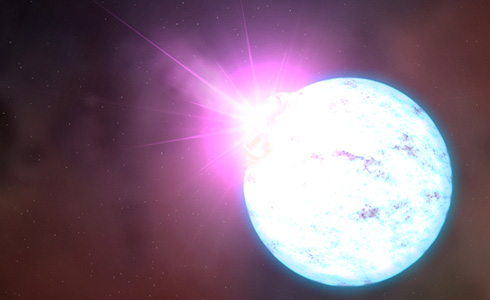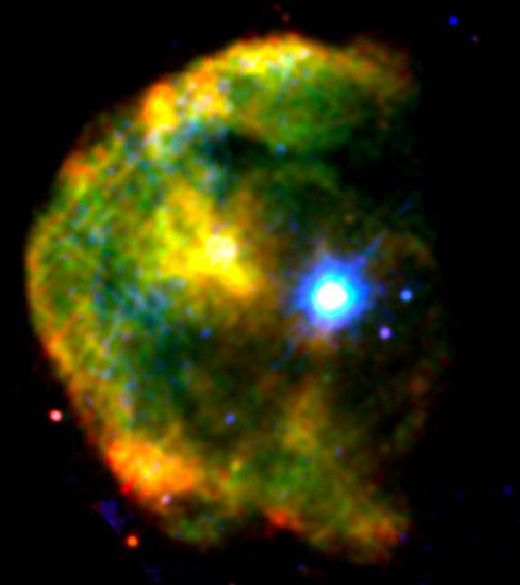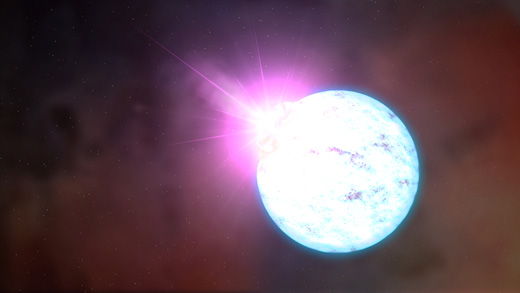Neutron star glitch needs new theories to explain it

Neutron stars are some of the strangest and least understood objects in the entire Universe. Over 1.5 times the mass of our whole solar system, squeezed into an object comparable in size with a city, these curious objects wield titanic gravitational fields and, often, immense magnetic fields. They’re also so incredibly dense that it’s difficult to fully appreciate* And sometimes, for reasons we don’t fully understand, their rotational speed suddenly changes.
These sudden changes in rotation are known as glitches, and they happen to a particular, rare type of neutron star, known as a magnetar – a neutron star with an exceptionally strong magnetic field, which occasionally undergoes violent outbursts known as starquakes. These starquakes have been known to cause the rotation speed of a neutron star to suddenly increase. But one of these oddities is an oddity among oddities. A magnetar known as 1E 2259+586 was recently observed not to speed up, but to slow down. The reason? No one knows.
The team in charge of this work, led by Victoria Kaspi at McGill University, Montreal, summed up their observation in a press release by saying that it “constitute[s] a new theoretical challenge.” Now, to someone like me, this is very exciting. Specifically because this means that, working with existing theories, they don’t know what’s going on. It’s currently unexplainable. And when this sort of thing happens, it means we’ve discovered something which we didn’t know before.
Any good scientist should be thrilled when they don’t understand something, because this means that there’s something new to understand. In this particular case, the fact that this magnetar seems to have done the opposite of what it should has managed to throw a spanner in the works**.

“Astronomers have witnessed hundreds of events, called glitches, associated with sudden increases in the spin of neutron stars, but this sudden spin-down caught us off guard,” Kaspi explained. Indeed, the regular type of glitch is, we think, quite well understood.
What precisely might be found beneath the ultra hard crust of a neutron star is a mystery. We might perhaps never be able to directly observe it and find out (neutron stars aren’t fond of guests, and have a tendency to turn anything which lands on them into a large thermonuclear explosion). But what we can deduce is that the interior of a neutron star is a kind of superfluid, composed mostly of neutrons. At the surface of a neutron star, high energy particles are accelerated outwards. This is known as a pulsar wind, and it’s the main mechanism through which neutron stars cool.
As this pulsar wind carries away energy, it gradually grains energy and momentum from the surface of the neutron star. But this causes stress to build up under the surface. After enough stress builds up, the crust ruptures with an almighty crack. This causes the star to emit a huge burst of x-rays. It also allows the crust to catch up with the rotation speed of the interior. Neutron stars slow down when they’re ready to and not a moment sooner.
The neutron star in question, 2259+586, lies around 10,000 light years away in the constellation of Cassiopaeia and rotates once every 7 seconds or so. In the x-ray image shown above, it’s quite obvious in high energy x-rays (coloured blue in the image). The lower energy x-rays show a pulsar wind nebula as those high energy particles streaming away from it crash headlong into the surrounding interstellar medium.
Crust fractures in neutron stars sometimes go by the name of starquakes, and they can be caused by tangled up magnetic field lines too. But it’s this particular mechanism which causes these stars to glitch. 2259+586, however, is going against the grain. Because it’s been observed to do the opposite of what it should, this previously unknown phenomenon has been dubbed an ‘anti-glitch’. What’s more, not content with its abrupt slowdown, 2259+586 is also slowing its speed faster than it was previously observed to (an effect known as “spinning down”).
Sometime in late April, before the anti-glitch was discovered, the Fermi space telescope picked up a powerful x-ray burst. Lasting just 36 milliseconds, the researchers believe that it was this burst which signalled the magnetar’s unprecedented drop in rotational speed. Robert Archibald, the lead author on the paper published on this work, explained, “What is really remarkable about this event is the combination of the magnetar’s abrupt slowdown, the X-ray outburst, and the fact we now observe the star spinning down at a faster rate than before.”
As for why this has happened? Well, now we need to wait for the theoreticians to solve the puzzle. And, at least for some of us, that’s the fun part!

* As one tumblr user so wonderfully described it, “an average printed period, if it were as dense as a neutron star, would weigh about as much as a train car FILLED WITH BRICKS.”
** A star mangled spanner, perhaps?
Hammonds M (2013-06-13 00:29:59). Neutron star glitch needs new theories to explain it. Australian Science. Retrieved: Dec 08, 2025, from https://ozscience.com/space/neutron-star-glitch-needs-new-theories-to-explain-it/
 Follow
Follow
Hi Markus,
As a humanities graduate (but also a lifelong amateur astronomer) I feel I know just enough about neutron stars to say I know very little about them at all. Nevertheless, I have always been fascinated by neutron stars – ever since reading ‘Frozen Star’ by George Greenstein back in the Ninetees, in fact. And as such, I read your article with deep interest. With regards to glitches, I suppose nothing as ‘ordinary’ as an asteroid impact upon the surface of an NS could possibly account for them? I suggest this because one hears so much about the tremendous energies liberated by such events. At the same time, It’s so hard for a non-mathematical person like myself to clarify these and related issues surrounding NSs once and for all. I hope these questions are not entirely meaningless or irrelevant.
Regards,
Graham Knott